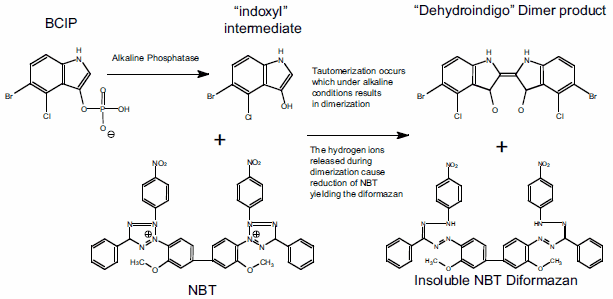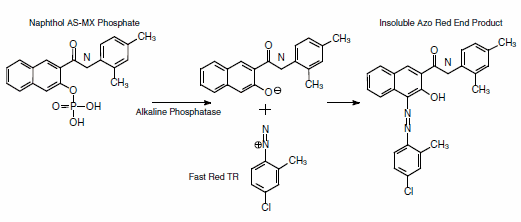Colorimetric Phosphatase/Peroxidase Substrate Systems
Substrates for Alkaline Phosphatase
Nitroblue Tetrazolium (NBT) is used with the alkaline phosphatase substrate 5-Bromo- 4-Chloro-3-Indolyl Phosphate (BCIP) in western blotting and immunohistological staining procedures. These substrate systems produce an insoluble NBT diformazan end product that is blue to purple in color and can be observed visually. Immunohistochemical staining with BCIP/NBT requires organic mounting media and can be counterstained with Nuclear Fast Red or Light Green. BCIP/NBT is generally a more sensitive method than Fast Red. We also offer proprietary formulations of BCIP analogs that utilize NBT and INTX to produce soluble end products specifically for ELISA applications.

Fast Red TR/Naphthol AS-MX and TR phosphate (4-Chloro-2-methylbenzenediazonium/ 3- Hydroxy-2-naphthoic acid 2,4-dimethylanilide phosphate) substrate systems have been formulated and optimized for use in immunohistology and western blotting as a precipitating substrate for the detection of alkaline phosphatase activity. Fast Red systems produce an insoluble intense red end product. Slides stained with Fast Red TR/Naphthol AS-MX must be coverslipped using aqueous mounting media as the reaction product is alcohol soluble.

pNPP substrates develop the yellow end-product, p-nitrophenol, when hydrolyzed by alkaline phosphatase. Since this system forms a soluble end product, it is suitable for ELISA , but not recommended for blotting or histochemistry. These products are supplied as ready-to-use buffered alkaline phosphatase substrate solutions containing p-NPP. The soluble yellow end product absorbs at 405 nm. The reaction may be stopped with the addition of 3 M sodium hydroxide solution. ELISA applications utilizing pNPP may be read in timed assays or stopped with alkaline solutions for delayed readings. The absorbance of the stopped reaction is also read at 405 nm. For ELISA applications, typically 200 microliters of substrate is added per well of the ELISA plate and the reaction is stopped with 50 microliters of 3M NaOH solution.
Materials
To continue reading please sign in or create an account.
Don't Have An Account?